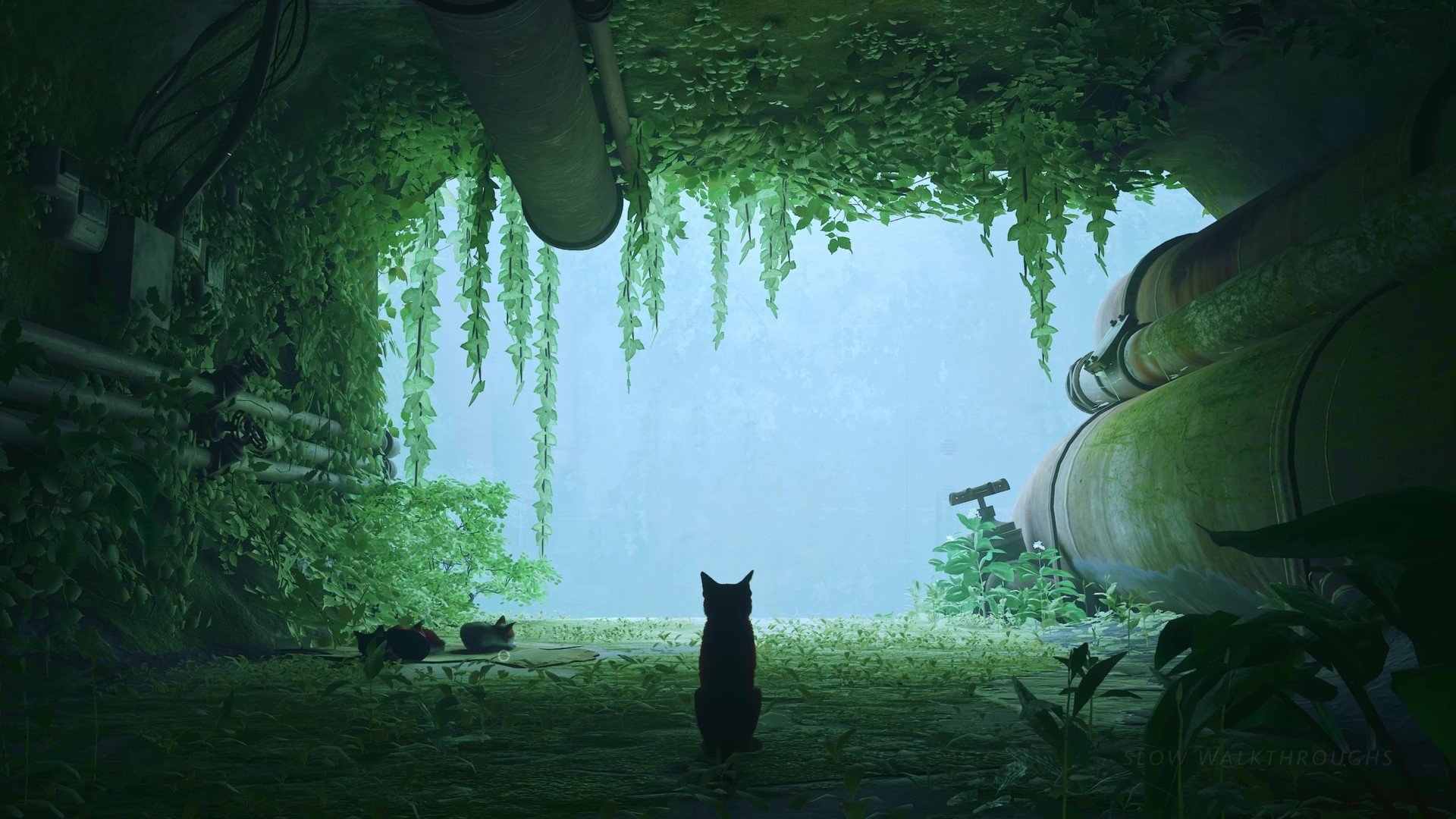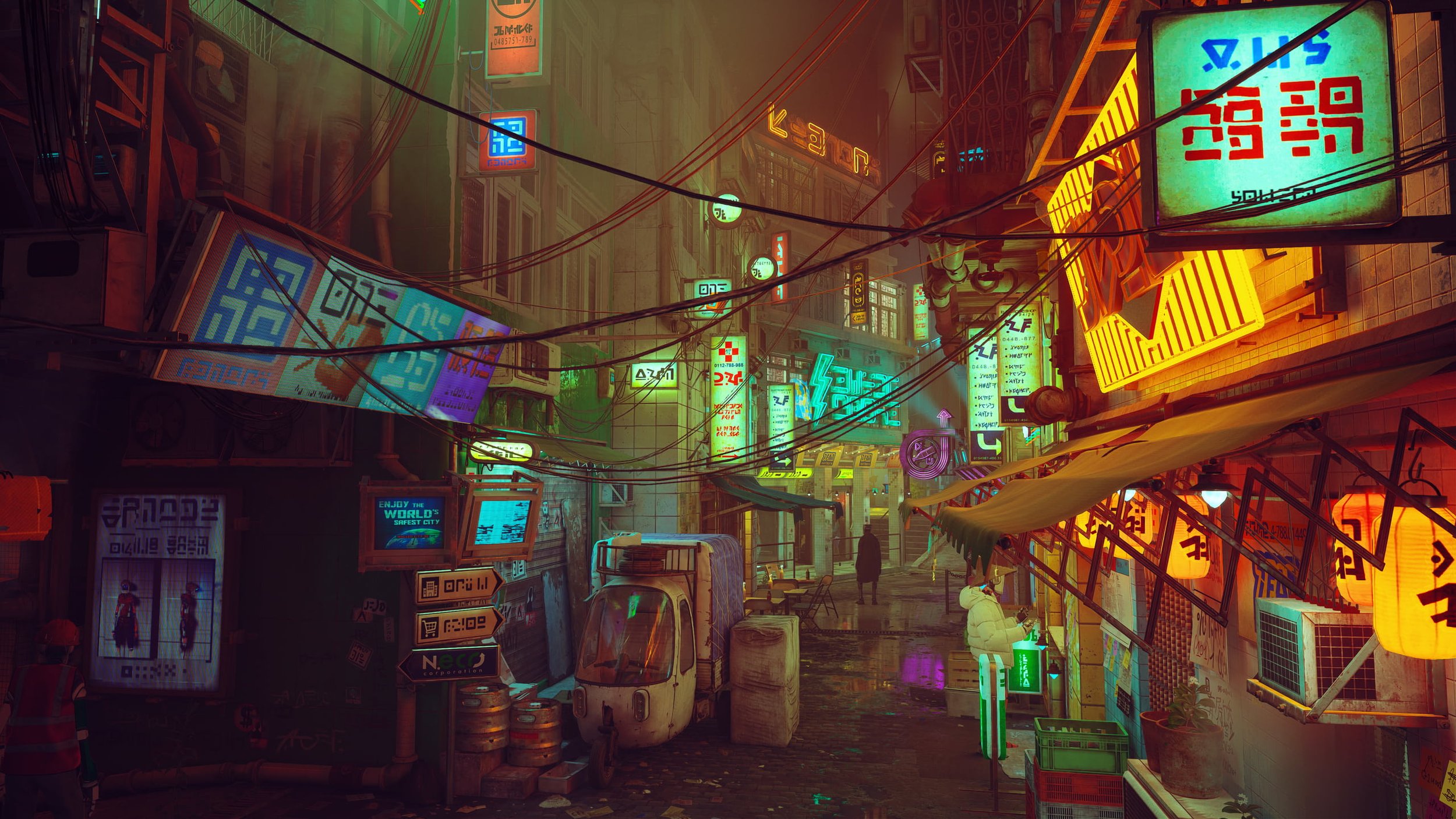Stray
A short, beautiful game where you explore a cyberpunk world as a cat—best enjoyed at a lazy, curious pace.
“We need you, little outsider.
Bring us to the sky!”
LEVEL UP YOUR PLAYLIST ↑↑↑
Why Stray is Worth Your Time
1. The Joy of Just Being a Cat
I didn’t expect to get hooked on Stray, but there’s something weirdly satisfying about how well it nails the simple stuff. Knocking things off ledges, curling up for a nap in a sunbeam, weaving between robot legs—it’s all stupidly fun in a way that shouldn’t work as well as it does. The game doesn’t overcomplicate it, and that’s the charm.
2. A World You Actually Want to Explore
Most games with "open exploration" feel like a checklist. Stray isn’t huge, but every corner of its cyberpunk slums feels handcrafted. The lighting, the sound design, the way your little cat paws click against pavement—it all adds up to a place that’s just nice to exist in. I played it on an OLED TV late at night, and it’s one of those rare games where I’d stop just to stare at the scenery.
3. No Pressure, Just Vibes
No grinding, no punishing difficulty, no guilt about ignoring the main quest. You can:
Take detours to mess explore
Hunt for hidden memories (or just hunt for a good napping spot)
Solve light puzzles that feel more like playful distractions than chores
It’s the kind of game you play to unwind, not to "beat."
4. A Quiet Story
I won’t pretend Stray has some mind-blowing narrative, but it doesn’t need one. The storytelling is subtle—more about the small moments between you and the world’s oddball robot residents. By the end, I was weirdly attached to places and characters that barely said a word to me.
Who’s It For?
People who like games that prioritize mood over mechanics
Players who appreciate slow, immersive exploration
Fans of short, polished experiences (~5 hours) that don’t overstay their welcome
Final Thought
Stray isn’t trying to be the next big thing, and that’s why it works. It’s a game that knows exactly what it is: a chill, beautifully crafted little adventure where the biggest thrill is seeing the world through new eyes. Sometimes, that’s all you need.
Gameplay
The Pure Joy of Being a Cat
Stray nails the feline fantasy. You don’t just control a cat—you become one. The game understands the little things: knocking objects off ledges, squeezing through tight spaces, and curling up for naps in unexpected spots. Movement feels fluid and natural, whether you’re leaping across rooftops or weaving through alleys. There’s no combat in the traditional sense; instead, you use the environment to outsmart threats, like luring enemies into traps or dodging Zurks in tense chase sequences. It’s a refreshing change of pace from games that rely on complex mechanics—here, your greatest tool is curiosity.
A Linear Adventure with Room to Explore
While the story progresses in a straightforward way, the game rewards those who take their time. Between scripted moments, you’ll explore dense, vertical neighborhoods packed with secrets. These areas feel alive, with robots going about their lives and hidden collectibles tucked away in clever spots. Some side quests, like tracking down sheet music for a musician bot or cracking a safe’s code, add depth without overstaying their welcome. I didn’t find everything on my first playthrough, and that’s part of the charm—there’s enough optional content to justify revisiting the world aside from it’s stunning visuals.
B-12: Your Robot Companion and the Heart of the Story
Your floating drone buddy, B-12, handles tasks your cat can’t (like translating robot speech), but they’re more than just a gameplay tool. Their relationship with the cat drives the narrative, and while your feline protagonist is mostly silent, B-12’s story gives the adventure emotional weight. The robots you meet along the way are surprisingly expressive, and their struggles—preserving memories, longing for the surface—add layers to what could’ve been a simple tale. It’s B-12’s journey as much as yours, and that shift in perspective works.
Where Stray Shines (and where it doesn’t)
The puzzles and platforming are solid, if unremarkable—don’t expect groundbreaking mechanics. But the game’s real strength lies in its atmosphere. The neon-lit slums and eerie underground zones are breathtaking, and the sound design pulls you deeper into the world. It’s a shorter experience (around five hours), but that brevity keeps the pacing tight. Stray might not revolutionize the genre, but it delivers a memorable, beautifully crafted adventure that sticks with you.
Verdict
Stray is a rare gem: a game that knows exactly what it wants to be. It’s a love letter to exploration, a masterclass in mood, and proof that sometimes, the simplest premises—like seeing the world through a cat’s eyes—can be the most compelling.

SPOILER AHEAD
The Story
The Hidden Depths of Walled City 99
At first glance, Stray presents a simple premise: a cat trying to return home. But beneath its surface lies a surprisingly profound story about human (and robotic) nature. The game slowly reveals that Walled City 99 wasn't just a shelter from environmental disaster—it was a failed quarantine zone during a plague that wiped out humanity. Through B-12's memories and environmental clues, we learn how even in extinction, class divisions persisted. The wealthy dumped trash into the slums, leading to the creation of the Zurks—a deadly "solution" that ultimately consumed everyone. It's a stark commentary on how societal inequality can persist even in the face of collective doom.
A Bleak but Believable Dystopia
The game's worldbuilding shines in its subtle details:
The Peacekeeper robots, unexplained but clearly oppressive, enforcing conformity through memory wipes
The neon light revolution, where slum-dwelling robots rebelled by simply turning on lights
The lingering effects of resource rationing and control
These elements aren't hammered home with exposition—they're discovered through optional conversations and environmental storytelling. The prison section is particularly haunting, showing the consequences of nonconformity in this broken society.
Why the Story Works (Despite Its Simplicity)
Stray isn't primarily a narrative-driven game, and that's okay. The plot unfolds slowly, matching the pace of exploration. While your cat's journey is straightforward (get home), the real story is about the world you pass through. What makes it compelling:
Environmental storytelling: The city's layout tells its own tale of class division
Robot personalities: Even minor NPCs add depth through small interactions
Gradual reveals: Major lore comes from optional discoveries, rewarding curiosity
It's not a 40-hour epic, but in its compact runtime, Stray delivers a surprisingly rich narrative—if you're willing to look for it.
Thoughts on the Narrative
This isn't a game that forces its story on you. The dystopian elements emerge naturally through exploration, making the world feel lived-in rather than constructed for the player's benefit. While your cat may just be passing through, the stories of Walled City 99—of resistance, inequality, and perseverance—linger long after the credits roll. That's the mark of effective storytelling: it makes you care about a world you're only visiting.

A Visual Masterpiece
If there’s one thing Stray absolutely nails, it’s the visuals. This isn’t just a pretty game—it’s one of those rare titles where every frame feels intentional, crafting an atmosphere that’s impossible to ignore.
Lighting as a Storytelling Tool
The use of light isn’t just technical—it’s emotional. Neon signs flicker through narrow alleyways, casting long shadows that make the world feel alive. Sunlight filters through broken rooftops, creating pockets of warmth in an otherwise cold, mechanical world. On an OLED TV with HDR, the effect is stunning—inky blacks make the city’s glow pop, while subtle reflections on wet pavement sell the illusion of a lived-in space.
A Cyberpunk World with Personality
While the game leans into familiar cyberpunk tropes (think Blade Runner’s slums), it avoids feeling derivative. The robots—with their CRT-screen faces and makeshift bodies—are full of charm. Their designs walk a perfect line between futuristic and cobbled-together, reinforcing the game’s themes of decay and resilience. Even small details, like the way their expressions glitch when surprised, add depth.
Attention to Detail
What truly sells the immersion:
Cat’s-eye view: The world is scaled to feline proportions, making every jump and crawl feel natural.
Environmental storytelling: Faded posters, abandoned homes, and layered architecture hint at the city’s history without a single line of dialogue.
Color grading: The slums’ muted blues and greens contrast sharply with the sterile whites of the upper city, visually reinforcing class divides.
Stray proves that visuals aren’t just about horsepower—it’s about artistry. Even without cutting-edge graphics, its cohesive aesthetic leaves a lasting impression.
The Visuals
Closing THoughts
+ Small note from me
At its core, Stray is a game that understands the power of perspective—not just in the literal sense of seeing the world through a cat’s eyes, but in how it frames its storytelling, its world, and even its quietest moments. It doesn’t try to overwhelm you with mechanics or overexplain its lore. Instead, it trusts you to take your time, to notice the details, and to feel the weight of a world that’s been left behind.
What I love most is how unhurried it all feels. There’s no rush to the next objective, no pressure to "git gud." It’s a game that lets you live in its spaces—whether that’s napping in a patch of sunlight, knocking over paint cans just because you can, or sitting with a robot as they strum a broken guitar. And yet, for all its simplicity, it leaves you with something deeper: a melancholy but hopeful reflection on what it means to exist in a broken world, and the small acts of connection that keep it alive.
Is it perfect? No. But it doesn’t need to be. Stray knows exactly what it wants to be—a short, beautiful, and deeply personal experience—and it delivers on that with confidence. By the end, I didn’t just feel like I’d played a game. I felt like I’d visited a place. And honestly? That’s rarer than it should be.
If you’re looking for something challenging or groundbreaking, this might not be it. But if you want a game that lingers—one that makes you pause, look around, and appreciate the quiet stories hidden in its corners—then Stray is worth every minute.
This is only my second post here—the first being my thoughts on The Alters—and I’m still figuring things out. The visuals, the tone, the way I structure my writing… it’s all a work in progress. I’m trying new things with each post, tweaking layouts, playing with how words and images fit together. Some of it will work; some of it won’t. That’s okay.
I don’t believe in "perfection." Not because it isn’t worth chasing, but because the chase itself is the point. There’s always room to be better—clearer, sharper, more thoughtful—and that’s what keeps me writing. Every post is a step forward, even if it’s a small one.
So, if you’re reading this: thank you. Thanks for sticking around while I experiment, while I find my voice. I’m not here to pretend I’ve got it all figured out. I’m just here because I love games, I love thinking about them, and I believe I can keep getting better at sharing why.
Next time, it’ll be something new. And it’ll be better. Not perfect—just better.








